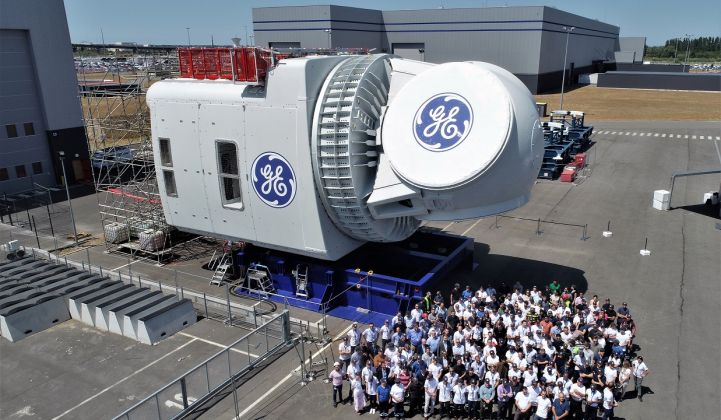General Electric finished manufacturing the first nacelle for its new 12-megawatt offshore wind turbine, known as the Haliade-X, as the company pushes to establish itself as an offshore market rival to Siemens Gamesa and MHI Vestas.
After unveiling the Haliade-X concept last year to great fanfare, GE on Monday said it will soon ship the first nacelle from its production site in Saint-Nazaire, France to an onshore testing site in the Netherlands. A second nacelle will be shipped later this year to an offshore test site in U.K. waters, leaving GE confident it will obtain its “type certificate” some time next year.
That leaves Haliade-X on track to begin commercial shipments by mid-2021, allowing GE to begin building its share in the cost-driven European offshore wind market, which is increasingly centered around competitive auctions.
Haliade-X "will be a game-changer if the technology and costs are balanced and controlled," said Shashi Barla, principal analyst covering the global wind supply chain and technology at Wood Mackenzie Power & Renewable.
There are no turbines currently for sale that are larger than 10 megawatts, Barla noted. The Haliade-X's larger rotor diameter will "increase the capacity factor for the turbines and result in higher [annual energy production] on a per-turbine basis," he said.
There are several potential challenges for Haliade-X in the market, however.
GE's track record in offshore wind is relatively thin, Barla said, with around 500 megawatts of installed capacity globally, compared to more than 15 gigawatts for Siemens Gamesa (including its licensing deal with Shanghai Electric in China).
Further, installation vessels may not be ready to cope with such large components when the turbine first hits the market, Barla added.
Playing catch-up
Already one of the world’s largest suppliers of onshore wind turbines, GE re-entered the offshore wind market through its 2015 acquisition of France’s Alstom.
GE has notched a few important wins in the offshore arena, notably the 396-megawatt Merkur project recently completed in the German North Sea and Ørsted’s 30-megawatt Block Island, the only operational U.S. offshore wind farm.
But with the 6-megawatt version of the Haliade platform losing ground to ever-larger competing models, GE doubled down in announcing its unprecedented 12-megawatt machine. A single Haliade-X erected off the coast of Germany could generate an estimated 67 gigawatt-hours of power a year, enough for 16,000 European homes, GE says.
Siemens Gamesa Renewable Energy and MHI Vestas currently dominate the market for offshore wind turbines, accounting for nearly three-quarters of cumulative global installed capacity, according to WoodMac. Their combined share is expected to shrink a bit over the next few years, but that’s largely due to the rise of Chinese suppliers in their own fast-growing domestic market.
While General Electric continues to look for ways to recover from its financial challenges of recent years, a period marked by deep restructuring and the departure of several CEOs, all signals point to ongoing investment and confidence in its standalone Renewable Energy unit, based in France.
The company is investing aggressively into Haliade-X to get it ready for the market. The blades for Haliade-X will also be made in France, by GE subsidiary LM Wind Power.
WoodMac forecasts 70 gigawatts of installed offshore wind capacity globally by the end of 2023, up from around 24 gigawatts currently.
GE is expected to begin expanding its offshore wind market share substantially from 2021, WoodMac says. Swedish utility Vattenfall, for one, has plans to use the Haliade-X in future projects.
Haliade-X “is an outstanding and strategic project for GE,” said John Lavelle, GE Renewable Energy’s offshore wind CEO, in a statement. “We are on track to start commercializing this new product very shortly.”
Block Island notwithstanding, GE has yet to win a breakout order in the snowballing U.S. offshore wind market.
Last week Siemens Gamesa took home a 1.7-gigawatt U.S. order from Ørsted, following the announcement of winners in New York's first offshore wind procurement.




